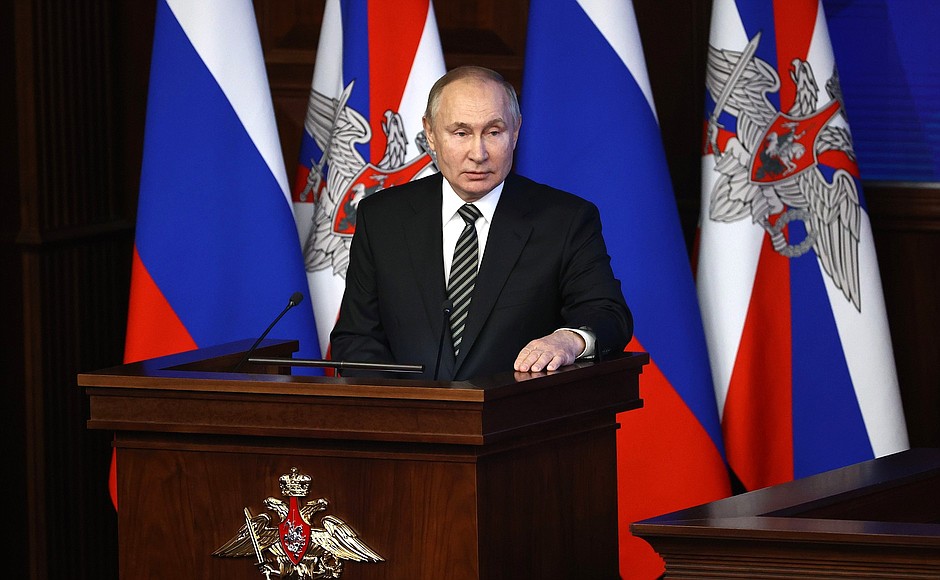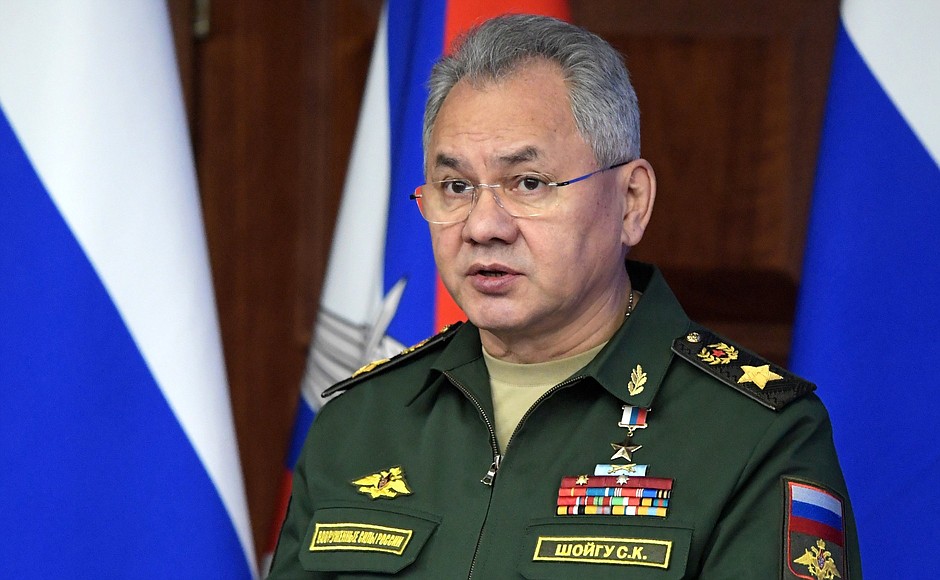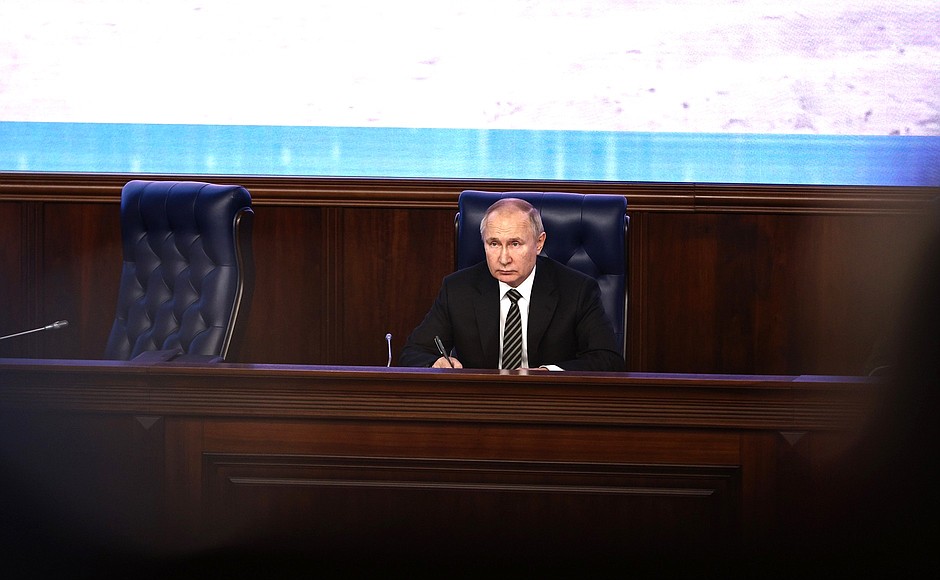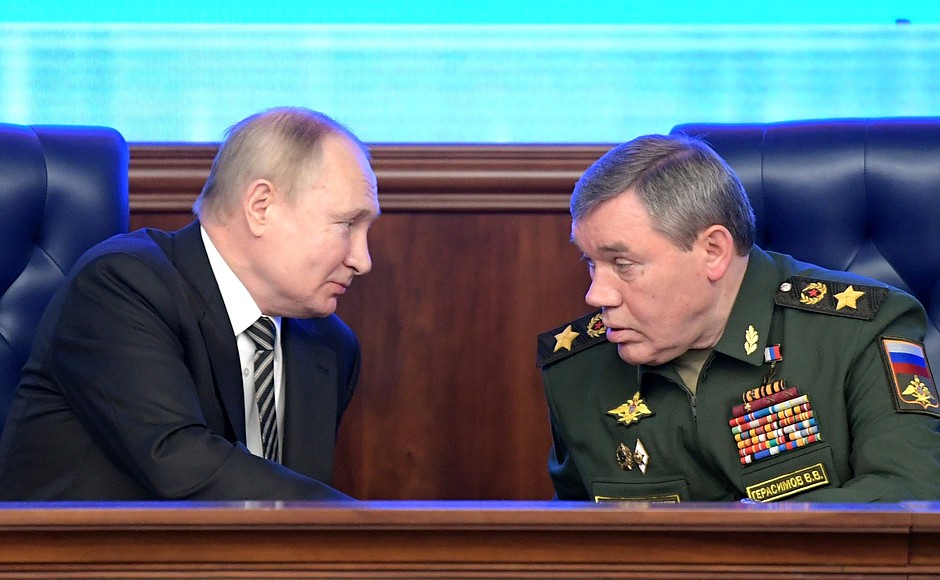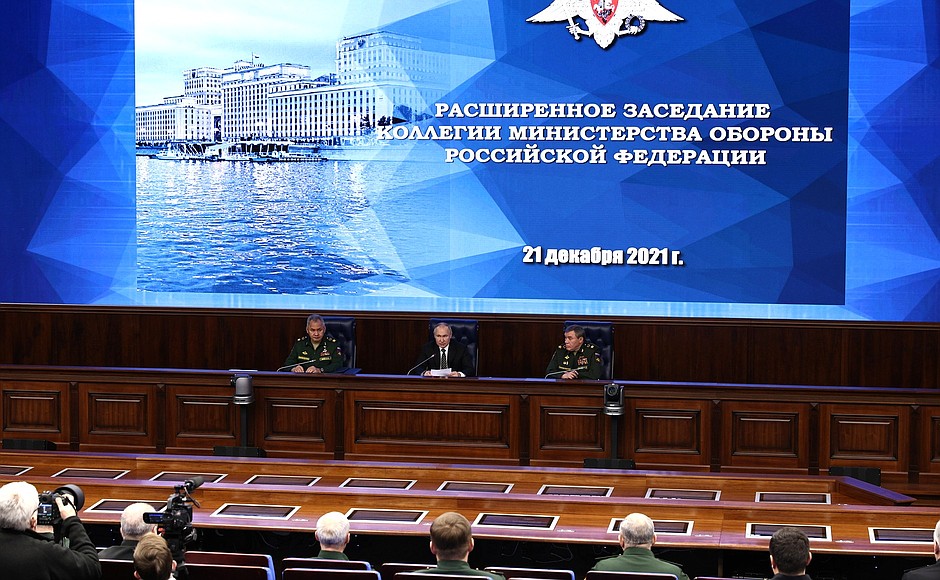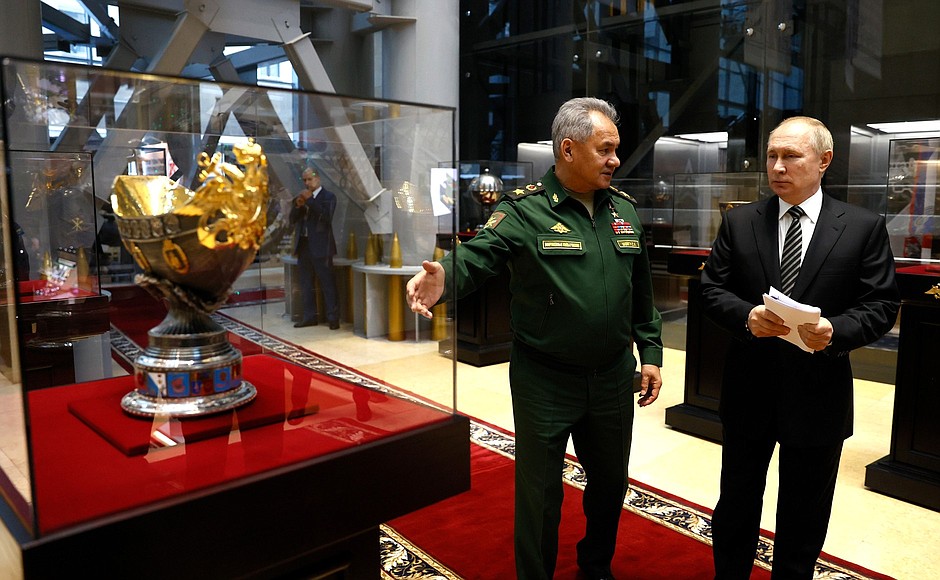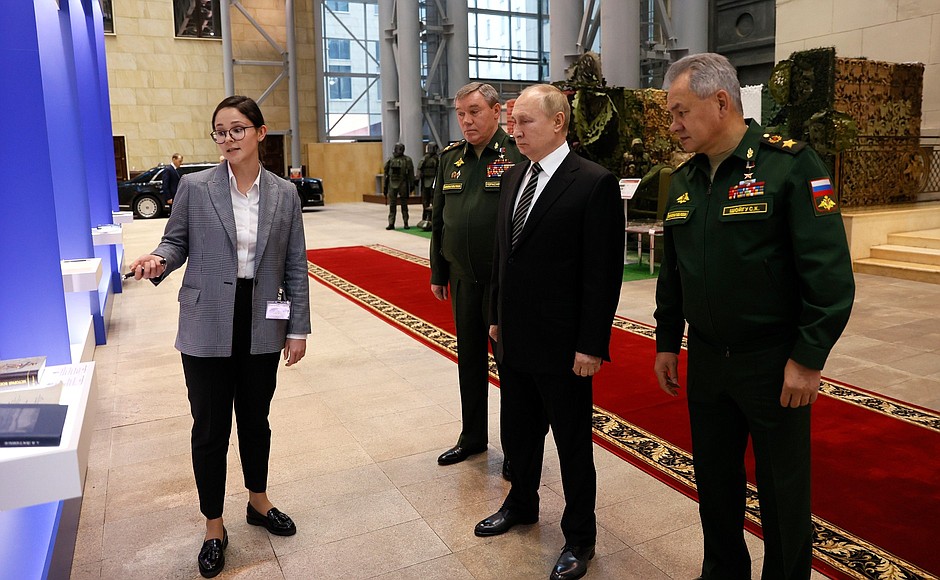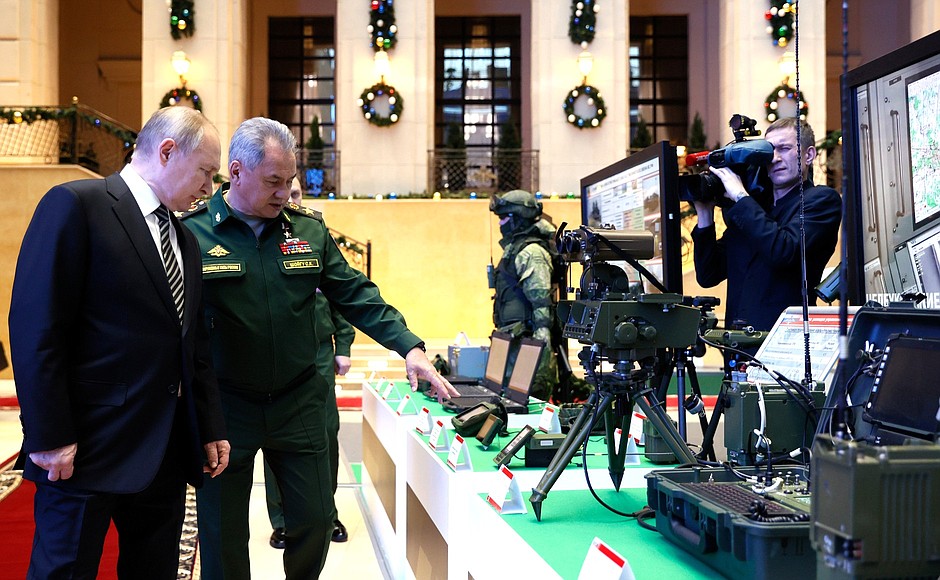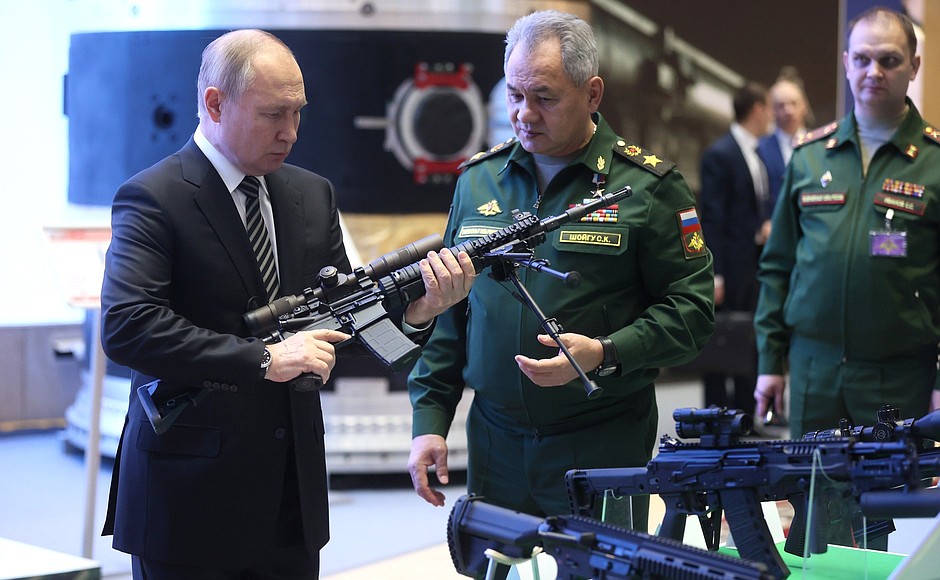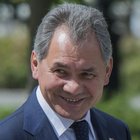Apart from the Armed Forces leadership, representatives of bodies of state power and public organisations, the meeting was attended by command officials from military districts, fleets and flotillas, military formations and units, as well as cadets and students of the Russian Defence Ministry’s higher education institutions, who have been invited to attend for the first time.
Following the meeting, the President toured a theme exhibition dedicated to the Defence Ministry Board’s final meeting in 2021. Accompanied by Defence Minister Sergei Shoigu, the President inspected promising samples of weapons and logistical support of the Russian army – advanced models of armaments, equipment, communications, intelligence and control.
* * *
President of Russia Vladimir Putin: Good afternoon, comrade officers,
Let us get down to work.
We have always prioritised and still prioritise the development of the Armed Forces and efforts to strengthen Russia’s defence capability, and we will continue to do this in the future.
Today, at the annual expanded meeting of the Defence Ministry Board, we will discuss what has been accomplished in the field of military development throughout 2021, what results have been achieved in the main areas, and, of course, we will chart future tasks. This is what we always do at the Board’s annual meetings.
I would like to note right away that, just like 2020, the outgoing year has been something extraordinary, mostly due to the continued coronavirus pandemic. You and I realise this. And it is of paramount importance that the Armed Forces efficiently and smoothly accomplish all of their tasks in this challenging context.
For example, work continued on the modernisation of the Army and Navy on a grand scale. Consequently, the share of modern weapons exceeded 71 percent in the troops and 89 percent in the strategic nuclear forces.
We continued to actively develop cutting-edge weapons systems. Some of them, namely the Avangard and Kinzhal systems, have been put on combat duty.
The Navy accomplished a wide range of tasks. Russian ships and submarines constantly patrolled all important sectors of the world’s oceans. A combined naval grouping and long-range aviation units successfully accomplished combat-training tasks in the Baltic and Northern seas and in remote areas of the Atlantic and Pacific oceans. A group of submarines and other ships did the same in the Arctic Ocean, operating in difficult ice conditions.
I also want to note a further increase in the level of troops’ combat training. The results of the Zapad 2021 joint strategic exercises have shown this convincingly as the participants successfully practiced accomplishing the tasks of ensuring the security of the Union State of Russia and Belarus.
Our military members in Syria acted honourably, as befits Russian soldiers. Their presence and assistance to the civilian population in solving humanitarian problems is making a tangible contribution to strengthening stability in that republic.
Our peacekeepers have been helping to maintain stability in Nagorno-Karabakh for over a year now. Largely thanks to their efforts, the humanitarian situation has improved in the region; several districts have been demined, the social infrastructure has been restored, and historical and cultural landmarks have been preserved. I would like to thank the personnel performing peacekeeping tasks for their professionalism, endurance and perseverance.
Military doctors deserve the highest praise for their hard work in difficult conditions, for their invaluable help to the civilian population: more than 30,500 patients have been treated at the Defence Ministry’s medical facilities, almost half of them civilians.
Military doctors have helped the civilian population in nine regions fight the coronavirus; they have even helped with the rehabilitation of patients who have suffered moderate or severe cases of the coronavirus infection and continue doing it. People continue to undergo rehabilitation treatment at 32 Defence Ministry health centres. Thank you.
I would like to emphasise that the army itself has taken the necessary measures to combat the spread of the coronavirus in its ranks. Almost 100 percent of military personnel have been vaccinated. This made it possible to stem the tide of infection and protect service members’ health, thereby ensuring high combat readiness among army units and divisions. True, the army has suffered from the coronavirus; there have been severe cases and losses – non-combat casualties. But overall, the Armed Forces have dealt with this problem successfully.
The military construction force has been operating with high efficiency. I am referring to more than building a significant amount of infrastructure for the army and navy on time. The military builders have also helped to ensure uninterrupted water supply to Crimea and Sevastopol. They have also helped build multifunctional medical centres and other socially significant facilities in many regions.
Comrade officers,
Relying on the solid foundation and a powerful research and technology achievements of the past few years, we must definitely continue to improve and strengthen our Armed Forces, which is exactly what we will do.
The military political situation in the world remains complicated, with increased conflict potential and new seats of tension in several regions. In particular, the growth of the US and NATO military forces in direct proximity to the Russian border and major military drills, including unscheduled ones, are a cause for concern.
It is extremely alarming that elements of the US global defence system are being deployed near Russia. The Mk 41 launchers, which are located in Romania and are to be deployed in Poland, are adapted for launching the Tomahawk strike missiles. If this infrastructure continues to move forward, and if US and NATO missile systems are deployed in Ukraine, their flight time to Moscow will be only 7–10 minutes, or even five minutes for hypersonic systems. This is a huge challenge for us, for our security.
In this context, as you are aware, I invited the US President to start talks on the drafting of concrete agreements. Incidentally, during our conversation he actually proposed appointing senior officials to oversee this sphere. It was in response to his proposal that we drafted our proposals on precluding the further eastward expansion of NATO and the deployment of offensive strike systems in the countries bordering on Russia. As you are aware, we have sent the drafts of relevant agreements to our American colleagues and the NATO leadership.
We need long-term legally binding guarantees. Well, we know very well that even legal guarantees cannot be completely fail-safe, because the United States easily pulls out of any international treaty that has ceased to be interesting to it for some reason, sometimes offering explanations and sometimes not, as was the case with the ABM and the Open Skies treaties – nothing at all.
However, we need at least something, at least a legally binding agreement rather than just verbal assurances. We know the worth of such verbal assurances, fine words and promises. Take the recent past, in the late 1980s and early 1990s, when we were told that our concerns about NATO’s potential expansion eastwards were absolutely groundless. And then we saw five waves of the bloc’s eastward expansion. Do you remember how it happened? All of you are adults. It happened at a time when Russia’s relations with the United States and main member states of NATO were cloudless, if not completely allied.
I have already said this in public and will remind you of this again: American specialists were permanently present at the nuclear arms facilities of the Russian Federation. They went to their office there every day, had desks and an American flag. Wasn’t this enough? What else is required? US advisors worked in the Russian Government, career CIA officers gave their advice. What else did they want? What was the point of supporting separatism in the North Caucasus, with the help of even ISIS – well, if not ISIS, there were other terrorist groups. They obviously supported terrorists. What for? What was the point of expanding NATO and withdrawing from the ABM Treaty?
They are to blame for what is happening in Europe now, for the escalation of tensions there. Russia had to respond at every step, and the situation was continuously going from bad to worse. It was deteriorating all the time. And here we are today, in a situation when we are forced to resolve it: After all, we cannot allow the scenario I mentioned. Is anyone unable to grasp this? This should be clear.
Sometimes I wonder: Why did they do all this in the then conditions? This is unclear. I think the reason lies in the euphoria from the victory in the so-called Cold War or the so-called victory in the Cold War. This was due to their wrong assessment of the situation at that time, due to their unprofessional, wrong analysis of probable scenarios. There are simply no other reasons.
I would like to emphasise again: we are not demanding any special exclusive terms for ourselves. Russia stands for equal and indivisible security in the whole of Eurasia.
Naturally, as I have already noted, if our Western colleagues continue their obviously aggressive line, we will take appropriate military-technical reciprocal measures and will have a tough response to their unfriendly steps. And, I would like to stress that we are fully entitled to these actions that are designed to ensure Russia’s security and independence.
As we know well, they are operating thousands of kilometres away from their national territory under different pretexts, including the need to ensure their own security. When international law and the UN Charter get in their way, they declare them obsolete and unnecessary. However, when something meets their interests, they immediately refer to the norms of international law, the UN Charter, international humanitarian law and so on. These manipulations are annoying.
In this connection, as I have already said, it is important to continue planned, steady, systemic development of the Armed Forces, including in line with their priorities, set forth in the latest version of the National Security Strategy and the Concept for Building and Developing the Armed Forces through to 2030.
Next year, we will have to focus on the following main tasks.
First, it is necessary to continue the planned and well-balanced procurement of modern weapons and equipment for military units and to devote special attention to deliveries of high-precision systems, cutting-edge reconnaissance, navigation, communications and control systems.
Second, combat and tactical training programmes should prioritise efforts to master modern weaponry, as well as new forms and methods of combat operations. In this connection, combat training programmes should be modified, so that they can be taken into account during exercises next year, including the Vostok 2022 strategic command post exercise.
Third, all-out success in many spheres now directly depends on well-thought-out and rapid decision-making. In the military sphere, during combat operations, decisions are made in minutes or even seconds. It is therefore necessary to develop systems to support the decision-making process by commanders at all levels, especially at the tactical level, and to introduce elements of artificial intelligence into these systems.
Fourth, it goes without saying that effective operational algorithms should be established at all levels, and advanced automatic systems should also be introduced. At the same time, we can see that modern military conflicts do not take place under pre-set patterns. As before, commanders play a key role in these conflicts. A lot depends on their knowledge, experience, personal qualities, and those who make truly unconventional decisions win battles. Consequently, during operational and combat training, it is necessary to train versatile commanders who possess knowledge in all fields. They should be listed in the personnel pool of top military commanders, and it is necessary to keep an eye on them even now, to guide them and to provide them with opportunities for subsequent promotion.
And, finally, here is the fifth aspect. Given the complicated international situation, it is necessary to develop military and military-technical cooperation with states that are members of the Shanghai Cooperation Organisation and the Collective Security Treaty Organisation and to pay special attention to strengthening the defence capability of the Russia-Belarus Union State.
Colleagues,
One of our absolute priorities is to increase the level of social guarantees for the military personnel. Defenders of the Motherland perform special tasks which are often highly complicated, demanding and perilous. We will make sure that they are duly rewarded for their service.
As in the previous years, the military allowance must be equivalent and even higher than the wages in the leading industries. We agreed on this with the Government several years ago.
For your information, we have managed to maintain this correlation. According to forecasts, the average wage across the economy as of the end of the year will be 55,000 rubles and the average wage in the leading industries (oil, finance and transport) will be 63,200 rubles. According to my data (the Finance Ministry’s numbers are slightly higher), the Defence Ministry’s average military allowance for lieutenants in 2021 is 81,200 rubles. The figure may differ as all lieutenants are different and serve differently – but the average level of compensation is 81,200 rubles while the leading industries show 63,200 rubles.
The Government must adjust the allowance for inflation and, of course, increase military pensions, in a timely manner and to the extent that will ensure that this correlation is maintained.
We continue to provide military personnel with permanent housing as planned. This year, 4,350 servicepeople purchased new flats using housing subsidies. In the course of the next three years, some 9,000 servicepeople will receive the subsidies. We plan to allocate around 113 billion rubles for this purpose from the federal budget.
The accumulative mortgage system continues to work effectively. Thanks to this programme, 15,000 military personnel have fulfilled their right to housing in 2021. Another 34,000 will obtain new housing in 2022–2024.
Service housing is provided at the same rate. Some 35,000 servicepeople will have obtained it by the end of the year, which is 14 percent higher than our plan.
We will continue to focus very closely on these and other issues concerning military personnel’s social security.
Finally, I would like to thank the leadership and staff of the Defence Ministry for their honest service and good performance. I am confident that you will continue to demonstrate professionalism and competence and use your best efforts to achieve high results. I wish you further success in your service for the benefit of Russia and our people.
Thank you.
Defence Minister Sergei Shoigu: Comrade Supreme Commander-in-Chief,
The global military political situation is deteriorating, and tension is growing on Russia’s western and eastern borders. The United States is increasing its forward-based deployment on Russia’s borders: a total of some 8,000 US rotation troops have been stationed in East European countries.
Regarding the US group of forces in Germany, the United States has re-activated the Theatre Fires Command, which was responsible for the use of intermediate-range missiles before 1991. The new Multi-Domain Task Force was formed which will be armed with various offensive missile systems.
Infrastructure for the deployment of a US armoured brigade is being created in Poland. The Aegis Ashore anti-missile capability will become operational soon. A similar BMD facility in Romania has already been put on combat duty.
The deployment of the Pacific segment of the global US BMD system is ongoing. A Joint Force Command of the Allied Command Operations (ACO) has been established in Norfolk to control maritime communications in the North Atlantic and the Arctic.
The United States and NATO are consistently increasing the scale and intensity of military training near Russia. These drills increasingly include the use of strategic aviation and simulated nuclear missile strikes at Russian targets. The number of flights by strategic aircraft near Russian borders has more than doubled. NATO pays special attention to redeployment of troops to the bloc’s eastern flank, including from the continental part of the United States.
The military drills include various scenarios involving the use of coalition groups of forces and non-NATO troops (Georgia, Moldova and Ukraine) against Russia. The desire of the Alliance to involve the Ukrainian armed forces in its military activities is threatening security, considering Kiev’s attempts at a military solution in Donbass.
The military development of Ukraine’s territory by NATO countries is underway. The situation is being further aggravated by the deliveries of US and allied helicopters, unmanned combat aerial vehicles and guided anti-tank missiles. The presence of over 120 members of US private military companies in Avdeyevka and Priazovskoye, Donetsk Region, has been proved reliably.
They are setting up firing positions in residential houses and social facilities and are preparing the Ukrainian special operations forces and far-right armed groups for active hostilities. Unidentified chemical warfare agents have been delivered to Avdeyevka and Krasny Liman for the purpose of provocations. The Ukrainian military keep up the shelling of civilian neighbourhoods in Donbass and the positions of the people’s militias of the Lugansk and Donetsk republics to provoke a response.
Destabilisation in Afghanistan is fraught with the export of terrorism and drugs to the CSTO countries.
We are closely monitoring the developments and promptly responding to all threats to military security.
The growing spread of the coronavirus is an additional factor that is affecting the situation. The Defence Ministry is making systemic efforts to counter it. Owing to the adopted measures, the rate of infection in the Armed Forces is 2.3 times below the national average, and the death rate is 50.4 times below it.
The number of laboratories in the Armed Forces has been increased by 8.5 times and the number of tests brought to 50,000 per week, which is 32 times more than the figure for civilian healthcare. The time for PCR tests has been reduced from 24 hours to 1.5 hour. The registration of a new test that produces results in 30 minutes is nearing completion.
Vaccines have been administered to 100 percent of army personnel and 70 percent of civilian staff. Planned booster shots are being administered under constant monitoring. Full-scale herd immunity has been achieved and maintained.
Owing to your support, a complex of high-tech facilities of the 27th Defence Ministry Research Centre has been built in less than a year. Medications against new infections are already being developed there.
The Defence Ministry is playing an active role in helping the civilian population. All your instructions on helping 16 regions and seven foreign countries with 5,000 medical workers, as well as supplying 71 tonnes of medications and over 1,000 tonnes of oxygen, have been fulfilled. All 32 hospitals built in 2020 are actively involved in eliminating the pandemic in all regions of Russia.
A series of measures on countering the coronavirus will allow us to maintain the high combat readiness of the Armed Forces, carry out all planned assignments and improve the quality of the army and navy.
As for the status of the Armed Forces, the staffing of officer positions has exceeded 96 percent. This year an additional 13,000 officers have been sent to the troops. The number of army personnel under contract has been double that of conscripts. Sixty seven percent of them have higher or secondary vocational education. Overall, the demographic setback of the past has been overcome and the staffing of the Armed Forces has reached 91 percent.
Today, all ground troop commanders have combat experience. The relevant figure for pilots is 92 percent, for air defence specialists 58 percent, and for the Navy 62 percent.
The chronic problem of permanent housing has been resolved after many years. Since 2018, army personnel have been receiving housing according to schedule. Over 19,500 people have been provided with permanent housing this year. The rates of providing service housing are not going down. This year, 35,000 people have received flats. Subsidies for housing sublease have been paid to over 64,000 army personnel.
The absolute majority of the service personnel support the defence activities of the state and trust the country’s leadership.
About increasing the combat capabilities of our Armed Forces: the Strategic Missile Force has completed the rearmament of the first missile regiment with the Avangard ICBMs with hypersonic glide vehicles. The first Yars launchers have been put on combat duty at two other regiments of the Strategic Missile Force.
The nuclear strategic aviation component has received four modernised Tu-95MS strategic missile platforms. One more Borei-A class nuclear-powered missile submarine armed with Bulava ballistic missiles has been put on combat duty in the Navy.
As the result of consistent, large-scale efforts undertaken at the direction of the Supreme Commander-in-Chief, the share of modern weapons in the country’s nuclear triad has reached a historic high of 89.1 percent.
A modern infrastructure is being created simultaneously with the delivery of the latest weapons to the Strategic Nuclear Forces. This year we have built 690 high-tech facilities.
Over 2,400 new and upgraded weapon system have been delivered to the Army, and motorised and tank divisions and missile as well as air defence brigades have been deployed.
Aviation and air defence missile brigades have been created in the Aerospace Forces. As many as 151 new and upgraded pieces of aviation equipment have been delivered.
The air and missile defence forces have been equipped with over 30 new systems, including the S-400 Triumf and S-350 Vityaz air defence systems. A separate aviation regiment has been created and equipped with the MiG-31K interceptors armed with Kinzhal hypersonic missiles.
The combat capabilities and command technology of the Integrated Space System (ISS) are being improved. The fifth Kupol satellite has been put into orbit. The construction of the western modernised ISS command station has been completed, and the station is operating in pilot mode. The trials of the Altius-RU long endurance UAV are over. Delivery of the Inokhodets and Forpost reconnaissance-strike UAVs is underway.
The runways and basic infrastructure have been renovated at 29 airfields over the past seven years as part of upgrading the Armed Forces basing system, so that the new aircraft delivered there can use them.
The Navy received three modern submarines, four surface ships, 10 assault boats, 17 ships and support boats, as well as three coastal missile systems. This year, the Navy saw four new military units formed, including an artillery regiment and a naval engineering regiment.
State tests of the Zircon sea-based hypersonic cruise missile are nearing completion. Serial deliveries will begin next year. The coastal infrastructure facilities in Baltiysk and Novorossiysk have been commissioned. The construction of service housing in Gadzhiyevo is nearing completion. It will fully cover the needs of families of submariners, including the crews of the new nuclear-powered cruiser submarines that will enter service within the next four years.
Almost 500 units of new and modernised equipment, 13,000 sets of landing equipment and parachute systems have been supplied to the airborne troops, and two airborne parachute regiments have been formed.
Thus, the rearmament task set by the Supreme Commander-in-Chief is being fulfilled diligently. The share of modern weapons in the equipment of the army and navy stands at 71.2 percent.
Measured in terms of modernisation, our Armed Forces are a global leader, while we rank ninth in terms of defence spending. As a result of the operational management of financial resources, over 258 billion rubles will be allocated to supply high-precision weapons. By 2026, the number of long-range high-precision weapon carriers will increase by 30 percent, and the number of cruise missiles of various types of deployment will double.
A number of innovations are being introduced to implement the state armament programme and the state defence order. This concerns the conclusion of long-term, up to 10 years, state contracts, ensuring timely delivery of weapons and equipment to troops, as well as technological preparedness and uniform workloads for industrial enterprises. The share of such state contracts amounted to 83 percent in 2021. The construction by 2030 of 34 surface ships and submarines, 20 of which are ships of the high seas range, is a positive example of their implementation. This approach will ensure continuity between the state armament programme in force until 2027 and the new programme until 2033 currently in the works.
An integrated approach to the maintenance and repair of aviation equipment is being implemented as part of the life cycle contracts that are concluded directly with the manufacturers based on the operating cost per flight hour. The terms and conditions of these contracts provide for the maintenance of 100 percent of the airplanes and helicopters in service. This made it possible to maintain the level of properly functioning aviation equipment at 83 percent or higher, which is more than double what we had in 2012.
The unified information system for state defence order settlements created by the Defence Ministry has become the country's first tool for ongoing automated monitoring and control over the use of budget funds. Today, it is a key tool for taking decisions on making advanced down payments to the defence industry companies and adjusting the state defence order. As a result, despite the existing restrictive measures, the state defence order was 99.4 percent fulfilled in terms of purchases, and 99.7 percent in terms of repairs and modernisation.
With regard to the force’s readiness to perform assigned tasks, the main event of the exercises was the joint Russian-Belarusian strategic exercise West-2021, which showed the ability of the newly created rank-and-file groups to effectively perform tasks to ensure regional security. About 200,000 servicemen were involved, including 2,000 from the CSTO, the SCO and other countries. Serially produced assault robotic systems were used on a large scale for the first time in battle formations.
The Armed Forces have carried out all planned combat training exercises, including 45 international exercises of various levels. This year, in the course of snap checks to test combat readiness of the troops, units and formations carried out regrouping at a distance of over 3,500 kilometres while carrying out training and combat missions at ranges outside assigned areas of responsibility.
For the first time in modern history, an operational exercise was conducted with a group of the Pacific Fleet forces in the high seas area, where the forces of the fleet carried out a covert deployment in a remote region of the Pacific Ocean.
An unparalleled integrated Arctic expedition Umka was conducted on the Franz Josef Land archipelago. All tested weapons have complied with their technical specs in high latitudes and low temperatures.
There is growing interest among foreign countries in the International Army Games. It is the largest event of its kind and took place on the territory of 11 states. More than 6,200 military personnel from 42 countries took part in them. The Games were attended by over 1.5 million spectators. Intense combat drilling made it possible to increase the level of training of commanders and staffs in performing tasks on unfamiliar terrain, as well as to improve the cohesion of the Armed Forces’ formations and units.
In terms of implementing tasks abroad, the Russian contingent continues performing its peacekeeping mission in Nagorno-Karabakh. It has discovered and destroyed 26,065 explosive devices and conducted 222 humanitarian operations. As a result, Nagorno-Karabakh has been living in conditions of ceasefire, peace and security for more than a year now.
The Russian contingent is the main guarantor of preserving peace in Syria. Aid was rendered to the Syrian state in settling the tensions that had escalated in the south of the country in summer. The direct participation of Russian advisors made it possible to avoid bloodshed and stabilise the situation in Daraa Governorate. Russian military personnel carried out over 3,000 humanitarian operations and delivered over 5,000 tonnes of cargo. Military medical workers rendered assistance to 132,000 civilians. Over 2,300,000 Syrian citizens returned to their pre-war places of residence.
We continue improving the military and social infrastructure of our military bases abroad. The work on expanding the Western runway has been completed at the Khmeimim air base. The construction of a cultural and leisure centre and a sports complex on an overall area of over 8,000 square metres has been completed in Armenia.
The Defence Ministry maintains cooperation with the armed forces of 109 countries. This graphically shows the futility of Western attempts to isolate Russia on the international arena.
We continued strengthening allied relations with the CSTO, the CIS and the SCO. This year we conducted the third joint air patrol with the People’s Liberation Army of China and the first marine patrol. We will continue this work.
China, India, Algeria, Egypt, Vietnam and Myanmar remain our main partners in military-technical cooperation. Delegates from 109 countries took part in the Ninth Moscow Conference on international security last June. This was the world’s largest military-political event in terms of its participants’ lineup.
The Army annual forum promoted international military-technical cooperation. It was attended by delegations from 117 foreign states, while the number of visitors exceeded 1.7 million people.
Advanced military training. We have completed the establishment of a network of Defence Ministry universities and the digital transformation of military education, creating an integrated digital educational environment at schools and research establishments. We have organised the enrolment of over 13,000 cadets and trainees. The number of male enrolment applicants was over six and female applicants – 17 per place.
As per your instructions, we have started to gradually increase the system of military training at civilian schools. At present, over 63,000 students are attending 104 military training centres.
New blocks have been completed and equipped with the latest educational and material facilities at the Omsk Cadet Corps. The construction of a sports centre with a swimming pool and a skating rink has been completed at the Tver Suvorov Military School. In the next two years, we will establish a Suvorov military school in Irkutsk, schools for girls in Krasnoyarsk and Khabarovsk, and a school for gifted children at the ERA Military Innovation Technopolis in Anapa.
Social protection. Mr President, thanks to your decisions, we have implemented additional social support measures for the military personnel who are protecting the security of the state under conditions involving risk to life.
The Defence Ministry has allocated an additional 180.2 billion rubles to increase the number of military personnel serving under contracts in 2021–2023. Military pay has been raised by 3.7 percent this year. In 2022 and 2023, it will be increased over and above the initial plan. These measures are increasing the attractiveness of military service and the number of highly skilled professionals willing to join the Armed Forces.
The Defence Ministry has created an efficient system of interaction with the authorities on issues of social support for military families. As a result, the number of military wives in need of jobs has decreased 19 times, and the number of children waiting for kindergarten places, 15 times.
Work is ongoing to provide additional opportunities and privileges to military personnel and their families. Under the Russian Army Partners loyalty programme launched on November 1, military personnel have access to a 30 percent discount for a broad range of goods sold at Voentorg partner stores.
The Defence Ministry’s decisions on military medicine made it possible to bring it to the most advanced positions in the country. Today, 50 military medical organisations are offering telemedicine services, with more than 1,500 of such services provided in 2021, which helped reduce overall morbidity among military personnel.
This year, the military construction complex has put into operation advanced Defence Ministry-operated medical facilities in Moscow, St Petersburg and Vladikavkaz, which made it possible to make qualified and specialised medical assistance available to a greater number of military personnel and civilians.
In addition, in accordance with your instructions, a new diagnostic centre has been built in Kyzyl. Work is underway to build medical centres in St Petersburg, Moscow, and Tula Region. The total area of the sites under construction will amount to almost 80,000 square metres.
Troop accommodation. Two military bases have been built on the Arctic islands and archipelagos, and in remote coastal areas. Combat duty of air defence units and coastal missile systems has been organised there. The renovation of five air fields to receive all types of aircraft is nearly complete. These measures made it possible to reliably protect Russia’s Arctic borders against foreign states’ aggressive military activities.
Special attention is paid to northern deliveries. This year, more than 72,000 tonnes of various cargoes were delivered to 152 hard-to-access deployment stations. The deliveries were completed by October 1.
Work to clean up the environmental damage to the Arctic continued. During the year, 3200 tonnes of scrap metal were collected and removed from the area. In all, over 28,000 tonnes of debris have been removed since this work began.
This year, the military construction complex has implemented major infrastructure projects on a tight schedule within three, four and seven months. This was achieved through the use of standard and modern technical projects. As a result, one ruble invested returned more than two rubles worth of newly introduced fixed assets.
Military settlements are being developed as planned. This year, 692 park and barrack housing area buildings and structures were built.
Teamwork to build refuelling complexes at military airfields continues with four more refuelling complexes built this year. Oil companies invested 21.4 billion rubles in this project.
The missile and ammunition storage system is continually improved with 66 new modern storage facilities built, which brought their total number to 602.
In accordance with the instructions issued by the President of the Russian Federation, a Railway Force unit is reconstructing the Baikal-Amur Mainline at the Ulak-Fevralsk section, which is 339 kilometres long. The preparatory work was completed in full ahead of schedule. New railway track is being laid at the Drogoshevsk-Skalisty section.
Property that is not used for the needs of the Armed Forces was transferred to municipal owners. This is an ongoing effort with 2,982 properties transferred this year. The funds thus saved were used to build new military infrastructure.
Military-political work. Commanders-in-chief and commanders of military-political bodies continued to maintain the high level of moral and political state of the forces and their readiness to perform combat missions in any conditions. At the same time, the range of tasks addressed by the military-political bodies is widening. Much is yet to be done in this sector.
In the year of the 76th anniversary of Victory, the Ministry of Defence has implemented major patriotic and cultural projects. Military parades were held in 28 cities. By tradition, the Main Naval Parade took place.
In order to preserve the historical memory, 86 combat standards have been handed over to the constituent entities of the Russian Federation. The museum and temple complex has become a destination for a true Russian pilgrimage. Over 100 major events were held on its territory since the start of the year, which were attended by nearly three million people. A total of 248 Patriot parks have been opened across the country, 29 of these this year alone.
Systematic work to educate young people in the military patriotic spirit has continued. Its core is the Young Army movement, which has embraced all the regions of Russia and includes over one million teenagers. This year, it has marked its fifth anniversary.
Jointly with the leadership of Moscow and Moscow Region, we have organised the Avangard Centre for Military Patriotic Education of the Youth. Since the start of the year, over 10,000 young men and women have undergone primary combat and military training there. Identical centres are being created in all cities with a population of over 100,000. In keeping with your instructions, 40 such centres have been established to date.
Earlier this year, the Defence Ministry organised a multi-function TV complex with studio hardware and equipment. It makes it possible to inform the public about the Armed Forces’ development and activities at a new qualitative level. Thus, all conditions are available for making patriotic films on this basis on orders from the Defence Ministry and other armed agencies.
Comrade Supreme Commander-in-Chief,
All the tasks assigned to the Armed Forces for 2021 have been accomplished. The Armed Forces’ combat capability has grown by 12.8 percent; the prescribed level of national defence capability has been ensured. The implementation of all signed contracts has ensured the delivery of over 5,000 main armament models. The rearmament of the Army and the Navy and regular servicing have made it possible to maintain military equipment in good condition at the level of 95 percent.
Over 3,000 buildings and facilities with a total floor area of 2.5 million square metres have been commissioned. In 2021, the overall volume of capital investment transferred to users has exceeded 155 billion rubles. Thereby, the number of unfinished construction projects has been considerably reduced.
Russian society has a high regard for the Defence Ministry’s activities. Over 90 percent of Russian citizens are confident that the Armed Forces are capable of defending the country, and 88 percent are proud of the Army and Navy.
I would like to outline high-priority tasks for 2022.
Under the rearmament programme, we need to provide the Strategic Missile Forces with 21 launchers, with Yars, Avangard and Sarmat intercontinental ballistic missiles and place them on combat duty. The Air Force’s strategic nuclear units should receive two Tupolev Tu-160M strategic missile carriers. The Generalissimo Suvorov, a Borei-A-class strategic ballistic missile submarine, should enter service with the Navy.
Regarding general-purpose forces. Ground Forces, the Airborne Forces and the Navy’s coastal troops should receive over 1,000 modern armoured vehicles, tanks and artillery systems. The Air Force and the Navy should receive 257 new and upgraded aircraft, as well as S-400 Triumf surface-to-air missile systems for five air-defence battalions. The Navy should receive five submarines, 11 ships and three gunboats. Military units should receive two coastal missile systems.
The number of contract service personnel should increase by 14,700. It is necessary to prepare and conduct the Vostok and Grom strategic command post exercise. We have to commission 3,000 buildings and structures simultaneously with procuring new weaponry and equipment. The digital transformation of recruiting offices should be completed in the next two years. On the one hand, this will make it possible to reduce personnel and on the other hand, to raise wages.
The Defence Ministry has accomplished a lot for the sake of boosting the country’s defence capability, but much remains to be done.
Thus, over the years, huge overdue infrastructure-overhaul projects have accumulated at military bases and settlements. We are taking action, but this is not enough. We will ask the Government to triple funding for these purposes. We will complete an inventory of housing for officers by the end of the first quarter of 2022, and we will later suggest a plan for financing the allocation of such housing, as well as the required funding for housing sub-lease contracts.
Comrade Supreme Commander-in-Chief,
In accordance with your instruction, we will continue to ensure the sustainable development of the Armed Forces and to enhance their combat capabilities throughout 2022. We will discuss the results of our activities in great detail at our limited-attendance meeting.
That concludes my report.
Vladimir Putin: On an informal note, I would like to add a few words to what the Minister said and what I said in my opening remarks. Everyone is discussing this and, of course, primarily the Armed Forces. I am referring to our documents, our draft treaties and agreements on ensuring strategic stability that we sent to the leadership of the United States and NATO.
We already see that some of our detractors are interpreting them as Russia’s ultimatum. Is it an ultimatum or not? Of course, not.
As a reminder: everything that our partners – let us call them that – the United States has been doing in previous years, supposedly ensuring its interests and security thousands of kilometres away from their national territory – they have been doing these tough things, the boldest things, without UN Security Council authorisation.
What was the pretext to bomb Yugoslavia? Was it authorised by the Security Council, or what? Where is Yugoslavia and where is the United States? They destroyed the country. Indeed, there was an internal conflict, they had their own problems, but who gave them the right to conduct airstrikes against a European capital? No one did. They just chose to do so, and their satellites were running behind them yelping along. So much for international law.
Under what pretext did they go into Iraq? It was Iraq developing weapons of mass destruction. They went in, destroyed the country, created a hotbed of international terrorism, and then it turned out that they made a mistake: “The intelligence failed us.” Wow! They destroyed a country. The intelligence failed – that is all they had to say to justify their actions. It turned out there were no weapons of mass destruction there. On the contrary, everything had been destroyed as agreed.
How did they go into Syria? With Security Council authorisation? No. They do as they please. However, what they are doing, or trying or planning to do in Ukraine, is not happening thousands of kilometres away from our national border. It is on the doorstep of our house. They must understand that we simply have nowhere further to retreat to.
There are experts here, sitting with us, I stay in constant contact with them. The United States does not possess hypersonic weapons yet, but we know when they will have it. It cannot be hidden. Everything goes on record, successful or unsuccessful tests alike. We have a sense of when it might happen. They will supply hypersonic weapons to Ukraine and then use them as cover – that does not mean that they will start using them tomorrow, because we already have Tsircon and they do not – to arm extremists from a neighbouring state and incite them against certain regions of the Russian Federation, such as Crimea, when they think circumstances are favourable.
Do they really think we do not see these threats? Or do they think that we will just stand idly watching threats to Russia emerge? This is the problem: we simply have no room to retreat. That is the question.
Armed conflicts and bloodshed are absolutely not our choice. We do not want to see events go that way. We want to use political and diplomatic means to resolve problems but we want to at least have clearly formulated legal guarantees. This is what our proposals are all about. We set them down on paper and sent them to Brussels and Washington, and we hope to receive a clear and comprehensive response to these proposals.
There are certain signals that our partners appear to be willing to work on that. However, there is also a danger that they will attempt to drown our proposals in words, or in a swamp, in order to take advantage of this pause and do whatever they want to do.
To make it clear to everyone: we are aware of this, and this turn of events, these developments, will not work for us. We look forward to constructive and meaningful talks with a visible outcome – and within a definite timeframe – that would ensure equal security for all.
This is what we will strive to achieve, but we can do so only if the Armed Forces are developing properly. In recent years, we have been able to manage this, and we have achieved a good level of combat readiness. I mentioned this, and the Minister has just reported about it. We are moving forward at a decent pace – the kind of pace that we need.
There are matters that need more attention, such as the production side, which we deal with on an ongoing basis. As you may be aware, we meet in Sochi twice a year. Why Sochi? It is not because of the good weather, but because everyone is going there, and we tune out distractions such as routine matters and focus on the defence industry and the development of the Armed Forces. These meetings are quite meaningful and effective.
To reiterate, there are many questions, but we are on top of them. I very much hope that we will continue to keep up this pace as we move forward in our efforts to ensure the security of Russia and its citizens.
Thank you very much. Happy New Year!
